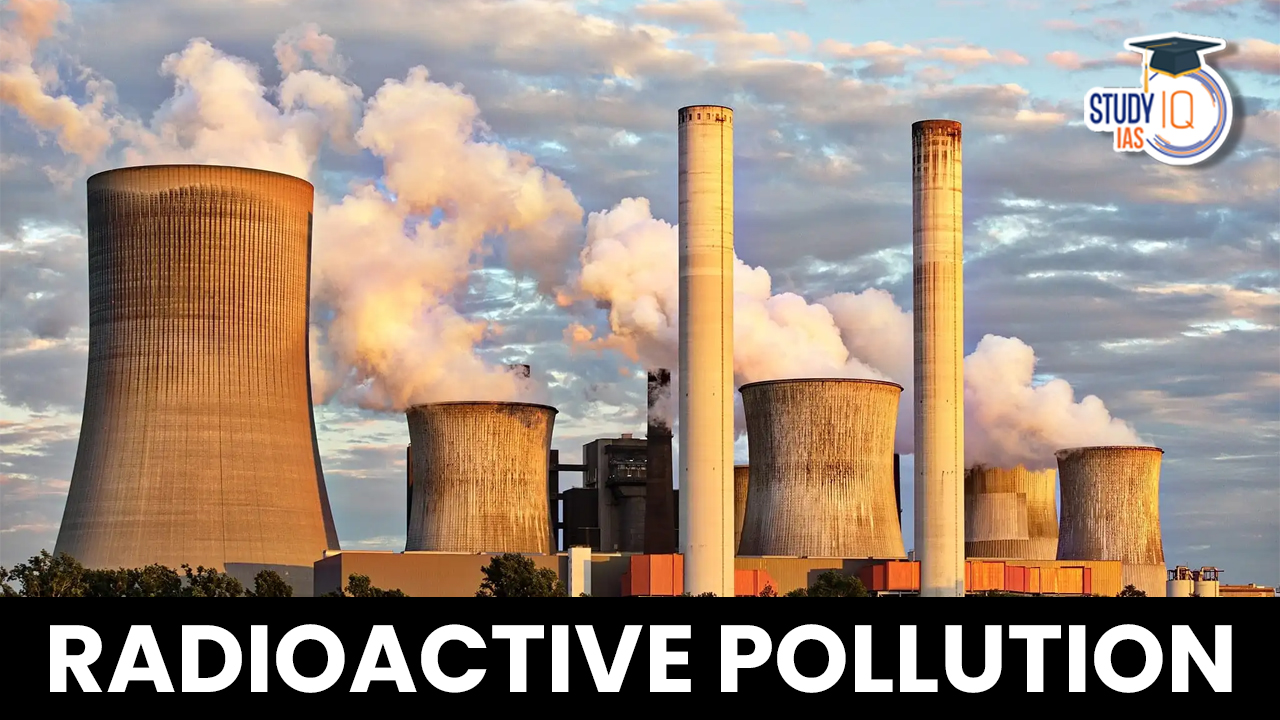Table of Contents
Radioactive Pollution
The term “radioactive pollution” refers to the hazardous level of radiation that radioactive materials emit. Ninety eight percent of the population’s dose and twenty percent of the population’s total exposure to radiation come from sources that are created by humans. Each year, more than 3600 million diagnostic radiological procedures, 37 million nuclear medicine procedures, and 7.5 million radiation treatments are carried out globally.
In rare cases of excessive exposure, high doses of radiation can cause chronic illnesses, cancer, gene mutations, cell degeneration, or even quick death. You will learn about Radioactive Pollution in this article, which will aid you while you study the UPSC Syllabus for Environment for the UPSC Civil Service exam.
What is Radioactive Pollution?
- When radioactive materials are present or added to the environment, especially when doing so unintentionally and endangering the environment through radioactive decay, this is known as radioactive pollution.
- The radioactive materials cause damage by releasing dangerous ionizing radiation into the environment where they are present, such as beta or alpha particles, gamma rays, or neurons.
- About 20% of the radiation humans are exposed to is thought to be caused by human activity.
- Human activities that can release radiation include those involving radioactive materials, such as mining, handling and processing radioactive materials, handling and storing radioactive waste, using radioactive reactions to produce energy, and using radiation in research and medicine.
Radioactivity
- Radioactivity is the term used to describe the spontaneous emission of particles or waves from the unstable nucleus of some materials. The three different categories of radioactive particles are alpha, beta, and gamma.
- Alpha particles are those that have a positive charge. Gamma rays are neutral electromagnetic radiations, whereas beta particles are negatively charged electrons.
- Natural radioactive materials exist in the crust of the world.
- Uranium, thorium, and actinium are three NORM (Naturally Occurring Radioactive Materials) series that damage water supplies.
Types of Radiation
Non-ionizing Radiation
- Non-ionizing radiation is a form of lower energy radiation that is incapable of removing electrons from atoms or molecules, regardless of whether they are a component of matter or living beings.
- Non-ionizing radiation includes, but is not limited to, visible, infrared, and ultraviolet light, microwaves, radio waves, and radiofrequency energy from cell phones.
- The chemicals and cells that they absorb are only partially able to be penetrated and affected by them.
- However, the majority of non-ionizing radiation types have not been proven to cause cancer.
Ionizing Radiation
- When ionizing radiation interacts with anything, including biological beings, it causes atomic-level modifications because it has enough energy to remove electrons from atoms or molecules.
- Ions, or electrically charged atoms or molecules, are often formed as a result of the modifications that are referred to as “ionizing” radiation.
- Examples of these radiations (radiations produced by radioactive elements) include X-rays, cosmic rays, and atomic radiations.
- Large molecules can be broken by ionizing radiation because of its potent ability to penetrate solid objects.
- The molecular damage may have long-range (delayed) or short-range (immediate) consequences.
Sources of Radioactive Pollution
Exposure to Cosmic Radiation
- The outer atmosphere of the earth is continually being attacked by cosmic radiation.
- Fast-moving particles that are present in space and can originate from a variety of sources, including the sun and other celestial events, make up cosmic radiation.
- Cosmic rays are mostly protons, but they can also be other particles or wave energy.
Terrestrial Radiation
- The Earth itself is the source of terrestrial radiation. Soil and rock can both contain naturally occurring radioactive elements.
- The main sources are uranium, potassium, and thorium natural deposits, which during natural decay generate small amounts of ionizing radiation.
- Both uranium and thorium are “ubiquitous,” or present practically everywhere.
Radiation through Inhalation
- The majority of fluctuations in natural radiation exposure are caused by the inhalation of radioactive gases produced by radioactive elements found in soil and bedrock.
- Radon, a radioactive gas that has neither an odor nor a color, is created when uranium-238 decays. Because it is an inert gas, it does not interact with its surroundings.
- Radon does not react, thus it can move readily through the soil and up into the atmosphere.
- A radioactive gas generated from thorium is called tron.
- The composition of the soil and bedrock has a significant impact on the amount of radon and thoron in the air.
Nuclear Power Plants
- The primary cause of the production of radioactive waste is the nuclear fusion process in nuclear power plants.
- These operations produce radioactive wastes that are a significant environmental risk connected with nuclear power facilities, including spent (used) reactor fuel, uranium mill tailings, and other radioactive wastes.
- These substances can remain radioactive for a very long time and are dangerous to human health.
Nuclear Waste Handling and Disposal
- Low to medium quantities of radioactivity can be produced over time through the treatment and disposal of nuclear waste.
- The air, water, and soil could all become contaminated by the radiation.
As a result, it could be challenging to recognize and foresee their effects. Additionally, certain nuclear waste sites might go unnoticed. - The main issue in handling radioactive waste is that it cannot be handled biologically or chemically.
Nuclear Weapons
- With the start of the atomic age came the first nuclear weapons tests, which led to the radioactive contamination of many areas all over the planet.
- The Stockholm International Peace Research Institute platform has statistics showing that 2053 nuclear tests were carried out worldwide between 1945 and 2006.
- One of the main causes of radioactive pollution was this.
Effects of Radioactive Pollution
Genetic Mutations
- Radiation has detrimental effects on DNA and genetics.
- Genetic decay results from the harm it causes to DNA strands over time.
- Depending on the quantity and type of radiation one has been exposed to, the degree of genetic mutation resulting in changes in DNA composition varies.
- A person or animal exposed to excessive radiation through the environment, food, or even water is likely to have already absorbed the radiation into their systems.
- Energy cannot be expelled, thus once within the body, it stays active.
One is very prone to cancer as a result of the mutation.
Diseases
- Radioactive pollution has a negative impact on our health. One of the rarest and deadliest side effects of radioactive pollution is acute radiation sickness.
- However, it is a result of radioactive radiation at high levels. This condition quickly results in nausea and vomiting.
- In the worst-case scenario, the person can pass away within a few days or weeks.
- Cancer is the most frequent adverse reaction to radiation and it can also cause it.
Soil Infertility
- Because soils are exposed to the atmosphere, radiation is a common occurrence in them.
- The soil’s radioactive chemicals react with different nutrients, destroying the nutrients and making the soil poisonous and infertile.
- Such soil causes the harvest of radioactively tainted crops that are dangerous for ingestion by both humans and animals.
Impact on Aquatic Life
- As a source of nuclear energy and chemical processing, power plants have been discharging radioisotopes into the water for many years.
- To mention a few, these include Cesium, Radon, Crypton, Ruthenium, Zinc, and Copper.
- The trash is not necessarily safe just because it is being released at a “permissible” level.
- Both the soft tissues and the bones of the fish contain these radionuclides.
- It was thought that the seaweed used in bread contained the ruthenium radioisotope
- Radionuclides are present in the tissues and shells of all fish with shells.
Measures to Control Radioactive Pollution
Proper Method of Disposing of Radioactive Waste
- Radioactive waste still contains radiation. It cannot be disposed of in the same way as conventional waste because of this.
- It can neither be buried nor burned. This trash should be kept in big, sturdy concrete containers because seepage is a possibility.
- Another option is to dilute the radiation because storage might not be practical.
Proper Labeling
- Any product containing radioactive material must be labeled, and the label’s content must include the necessary safety instructions.
- This is because radiation can enter the body through very slight interaction with radioactive material.
- To encourage the use of protective equipment when handling them, containers containing hazardous products must to be prominently marked.
Prohibition of Nuclear Tests
- It has previously been proven that nuclear energy has a significant amount of latent destructive power.
- However, the tests made to improve the energy have a big impact on the total amount of radioactive elements.
- These tests also end up leaking into adjacent ecosystems despite being done in deserts, affecting many people’s livelihoods.
Alternative Energy Sources
- Nuclear power development and use were initially not bad things.
- But given the harm and dangers it does to the environment, it is long past due for its use to be phased out in favor of more eco-friendly energy sources like renewable energy (solar, hydroelectric, and wind power).
- The waste released from the various processes and combustion causes additional radiation to be released into the atmosphere when radioactivity is used to generate energy in nuclear power plants, for instance.
Regulatory Measures
- The executive organization in charge of all nuclear energy-related activities is the Department of Atomic Energy (DAE), which was established in 1954.
- Locations for nuclear installations are chosen with safety in mind.
- In order to stop any significant radiation leakage from the reactor, a number of structural barriers are envisaged.
- Employee radiation exposure is evaluated on a monthly basis.
- The Atomic Energy Regulatory Board (AERB) has established a 30 millisievert (mSv) personnel exposure limit.
- This complies with the standards set by the International Commission on Radiological Protection (ICRP).
- All safety and regulatory obligations imposed by the Atomic Energy Act of 1962, which is applicable to all Department of Atomic Energy institutions, are carried out by the Atomic Energy Regulatory Board, a separate division of the Atomic Energy Commission.
- It also has the power to decide on all nuclear installations’ locations, plans, implementation, and upkeep.


 How African Reserves Eliminated Rhino Po...
How African Reserves Eliminated Rhino Po...
 Why India Needs Its Own Economic Model?
Why India Needs Its Own Economic Model?
 Challenges in India’s Airline Sector: ...
Challenges in India’s Airline Sector: ...

























